Abstract
HYDROMEDUSAE swim by rhythmically contracting the circular swimming muscles located in the subumbrella. When species such as Stomotoca atra1, Sarsia tubulosa2,3, Proboscidactyla flavicirrata4 and Euphysa japonica2 are disturbed, either by electrical or mechanical stimulation of the exumbrellar surface, the tentacles contract, swimming stops and a tetanic contraction of the radial muscles causes an infolding of the bell margin (Fig. 1b). This protective response is called crumpling5 and is initiated by all-or-nothing potentials in the nerve-free, exumbrellar epithelium1–4. S. atra, a predacious hydromedusa, is atypical in that it crumples both when disturbed and when in the proximity of large numbers of hydromedusae of several other species. The latter response is initiated by a stimulating substance stored in the mesogloea of the other medusae6. The substance is found in crude extracts of Aequorea aequorea, Halistaura cellularia, Phialidium gregarium and S. tubulosa, but not in S. atra itself. The crumpling response induced by the extract has been suggested to be a feeding response, trapping prey in the infolded margin6. By recording the electrical activity during the crumpling response initiated by extracts of A. aequorea I have found that this response is coordinated differently from crumpling initiated by electrical or mechanical stimulation.
This is a preview of subscription content, access via your institution
Access options
Subscribe to this journal
Receive 51 print issues and online access
$199.00 per year
only $3.90 per issue
Buy this article
- Purchase on Springer Link
- Instant access to full article PDF
Prices may be subject to local taxes which are calculated during checkout
Similar content being viewed by others
References
Mackie, G. O. J. Neurobiol. 6, 357–378 (1975).
Mackie, G. O. Passano, L. M. & Pavans de Ceccatty, M. C.r. hebd. Séance Acad. Sci., Paris 264, 466–469 (1967).
Mackie, G. O. & Passano, L. M. J. gen. Physiol. 52, 600–621 (1968).
Spencer, A. N. Am. Zool. 14, 917–926 (1974).
Hyman, L. H. Biol. Bull. 79, 282–296 (1940).
Lenhoff, H. M. Biol. Bull. 126, 115–120 (1964).
Mackie, G. O. & Singla, C. L. J. Neurobiol. 6, 339–356 (1975).
Author information
Authors and Affiliations
Rights and permissions
About this article
Cite this article
SCHWAB, W. Electrical responses of Stomotoca atra induced by an extract of Aequorea aequorea. Nature 267, 701–702 (1977). https://doi.org/10.1038/267701a0
Received:
Accepted:
Published:
Issue Date:
DOI: https://doi.org/10.1038/267701a0
This article is cited by
-
Nerves in the endodermal canals of hydromedusae and their role in swimming inhibition
Invertebrate Neuroscience (2008)
Comments
By submitting a comment you agree to abide by our Terms and Community Guidelines. If you find something abusive or that does not comply with our terms or guidelines please flag it as inappropriate.



